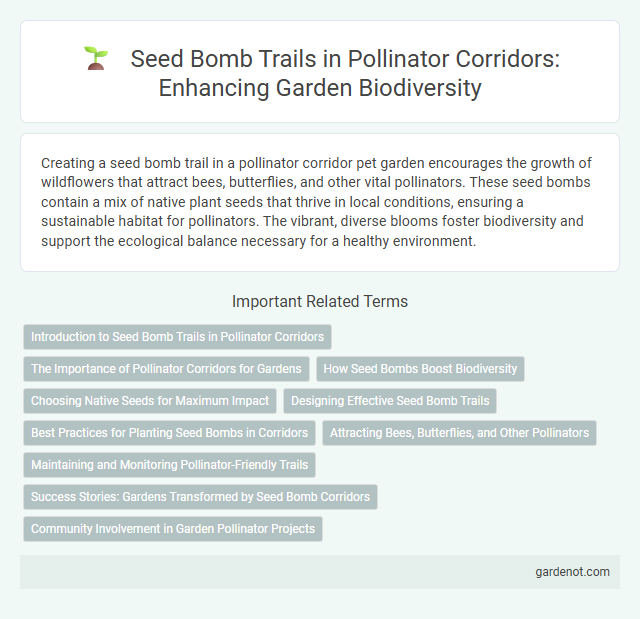Creating a seed bomb trail in a pollinator corridor pet garden encourages the growth of wildflowers that attract bees, butterflies, and other vital pollinators. These seed bombs contain a mix of native plant seeds that thrive in local conditions, ensuring a sustainable habitat for pollinators. The vibrant, diverse blooms foster biodiversity and support the ecological balance necessary for a healthy environment.
Introduction to Seed Bomb Trails in Pollinator Corridors
Seed bomb trails enhance pollinator corridors by dispersing native wildflower seeds in targeted areas, boosting habitat connectivity for bees, butterflies, and other pollinators. These seed bombs, composed of a nutrient-rich mixture including clay, compost, and seeds, allow for efficient, hands-on restoration of degraded landscapes. Establishing seed bomb trails supports biodiversity, improves plant-pollinator networks, and strengthens ecosystem resilience in urban and rural settings.
The Importance of Pollinator Corridors for Gardens
Pollinator corridors play a crucial role in supporting biodiversity by connecting fragmented habitats, allowing bees, butterflies, and other pollinators to access diverse floral resources throughout the seasons. Seed bomb trails, embedded with wildflower seeds, enhance these corridors by promoting the growth of native plants that provide essential nectar and pollen sources. Establishing and maintaining pollinator corridors within gardens boosts ecosystem resilience and improves crop yields through effective pollination services.
How Seed Bombs Boost Biodiversity
Seed bombs enhance biodiversity by dispersing native wildflower seeds across urban and degraded landscapes, creating habitats rich in nectar and pollen for pollinators such as bees, butterflies, and birds. The concentrated seed clusters improve germination rates and promote diverse plant growth, which supports a variety of insect species essential for ecosystem stability. Establishing seed bomb trails facilitates continuous pollinator corridors that connect fragmented habitats and increase genetic diversity among plant populations.
Choosing Native Seeds for Maximum Impact
Selecting native seeds for a pollinator corridor seed bomb trail ensures optimal adaptation to local climate and soil conditions, promoting robust plant growth and sustained floral resources. Native seed varieties support regional pollinators by providing familiar nectar and pollen sources, enhancing biodiversity and ecological resilience. Incorporating diverse native species maximizes habitat quality, attracting a wider range of pollinators and improving ecosystem health.
Designing Effective Seed Bomb Trails
Designing effective seed bomb trails involves selecting native wildflower seeds that thrive in local ecosystems to maximize pollinator attraction and biodiversity support. Trail placement should ensure optimal sunlight exposure and soil conditions to enhance seed germination and establish continuous floral resources for bees, butterflies, and other pollinators. Incorporating a diverse mix of flowering plants with staggered bloom times sustains pollinator activity throughout the growing season, improving corridor connectivity and habitat resilience.
Best Practices for Planting Seed Bombs in Corridors
Plant seed bombs in pollinator corridors by strategically selecting native wildflower species to enhance habitat connectivity and support biodiversity. Disperse seed bombs evenly along sunlight-exposed pathways with well-drained soil to ensure optimal germination rates and plant growth. Maintain regular monitoring and minimal disturbance to promote successful establishment of nectar-rich plants vital for pollinator health.
Attracting Bees, Butterflies, and Other Pollinators
Seed bomb trails create vibrant habitats that attract bees, butterflies, and other essential pollinators by dispersing native wildflower seeds rich in nectar and pollen. These trails enhance local biodiversity and provide crucial foraging resources that support pollinator health and reproduction. Establishing continuous corridors ensures safe passage and connectivity, boosting pollination activity across fragmented urban or agricultural landscapes.
Maintaining and Monitoring Pollinator-Friendly Trails
Maintaining and monitoring pollinator-friendly trails, such as seed bomb trails, involves regular inspection to ensure seed dispersal areas remain undisturbed and vegetation thrives. Utilizing GPS mapping and mobile apps facilitates precise tracking of pollinator activity and trail conditions, promoting adaptive management. Consistent data collection on flower diversity and pollinator visits supports the health of ecosystems and sustains effective corridor connectivity.
Success Stories: Gardens Transformed by Seed Bomb Corridors
Seed bomb trails have revitalized urban and rural gardens by introducing native pollinator-friendly plants that enhance biodiversity and support ecosystems. Communities participating in these corridors report increased pollinator activity, healthier plant growth, and a noticeable boost in local wildlife populations. These success stories highlight the effectiveness of seed bomb corridors in creating sustainable habitats for bees, butterflies, and other crucial pollinators.
Community Involvement in Garden Pollinator Projects
Community involvement in pollinator projects, such as seed bomb trails, significantly enhances local biodiversity and supports pollinator populations. Engaging residents in creating and deploying seed bombs fosters environmental stewardship and raises awareness about pollinator-friendly plants native to the region. Collaborative efforts in pollinator corridors strengthen ecosystem resilience by connecting fragmented habitats and providing vital nectar and pollen sources.
Seed bomb trail Infographic

 gardenot.com
gardenot.com